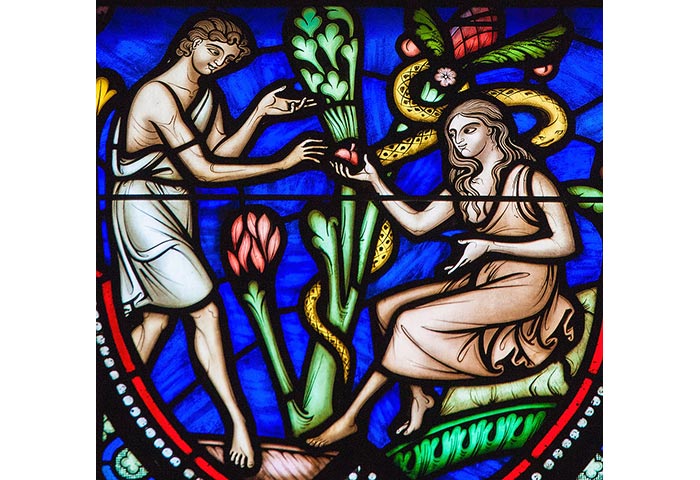Introduction
That all men are mortal is a statement so uncontroversial, it has long served as a stock premise in logic textbooks. That most men would prefer not to be so is equally well known, and has remained more or less constant from the quest of Gilgamesh to the transhumanist movement of our own day. It is often cited by Christian apologists as evidence of man’s destiny of eternal life in communion with God: we desire to live forever because we were made to live forever.1
Does it follow, however, that the first and unfallen man was created with an immortal nature? Paul’s statement that “sin came into the world through one man, and death through sin” (Romans 5:12) might be taken to mean that man was immune from death prior to the fall.2 According to Stephen B. Clark, however, the presence of the tree of life in the garden of Eden indicates that Adam and Eve were mortal:
“If Adam were to eat of the tree of life, he would live forever. The fruit would impart some kind of immortality, enabling human beings to overcome a limitation they had as a result of the way they were created. Sooner or later they would die, at least physically, unless they ate of the tree of life.”3
So was unfallen man mortal or immortal? As this paper will show, Clark’s position is consistent with that of the earliest Christian teaching, most notably Athanasius in his dual treatise Against the Heathen – On the Incarnation, and has been maintained through subsequent developments in the Christian theological tradition.
Athanasius on Original Mortality
Man’s original mortality is a key assumption underlying Athanasius’ account of creation, fall, and redemption:
For if, out of a former normal state of non-existence, they were called into being by the Presence and loving-kindness of the Word, it followed naturally that when men were bereft of the knowledge of God and were turned back to what was not (for what is evil is not, but what is good is), they should, since they derive their being from God who IS, be everlastingly bereft even of being; in other words, that they should be disintegrated and abide in death and corruption. For man is by nature mortal, inasmuch as he is made out of what is not.4
For Athanasius, mortality follows from creatureliness: man’s natural inclination is to return to the nothingness from which he was created. The proposition is similar to Aristotle’s theory of natural motion: just as the element of earth moves earthward, and fire ascends toward the empyrean, so the natural motion of that which is made from nonbeing is to dissolve back into nonbeing.
One can also explain the tendency toward disintegration in terms of corporeality, as Athanasius does when he defends the doctrine of an incorporeal God against polytheistic notions of corporeal divinities: “And generally, if they conceive the Deity to be corporeal … it follows that it must be capable of all other bodily casualties as well, of being cut and divided, and even of perishing altogether.”5 The same argument refutes pantheism:
But the following point, drawn from the observation of our human body, is enough to refute [the pantheistic philosophers]. For just as … a single body is composed of these distinct parts – having its parts combined for use, but destined to be divided in course of time when nature, that brought them together, shall divide them at the will of God, Who so ordered it – thus … if we combine the parts of creation into one body and proclaim it God, it follows … that He is destined to be divided again, in accordance with the natural tendency of the parts to separation.6
Athanasius’ reasoning is simple: what is corporeal has parts; what has parts can be divided; what can be divided can be destroyed. This places the incorporeal, indivisible, and immortal God in one column, and corporeal, composite, mortal man in the other. Khaled Anatolios calls this “a strict ontological dialectic between a creation that comes to be from nonbeing and an uncreated divinity.”7
According to Athanasius, however, man enjoys an advantage over the rest of creation, because God “made them after His own image, giving them a portion even of the power of His own Word; so that having as it were a kind of reflection of the Word [logos], and being made rational [logikoi], they might be able to abide ever in blessedness, living the true life.”8 As Anatolios points out, this statement by Athanasius is “simultaneously anthropological and christological: to be created according to the Image is to be granted a participation in the one who is the true and full Image of the Father.”9 It was man’s participation in the Word, and not the possession of an immortal nature, that preserved him, prior to the fall, from the death to which his corporeal substance was naturally prone:
“For because of the Word dwelling with them, even their natural corruption did not come near them, as Wisdom also says: ‘God made man for incorruption, and as an image of His own eternity.’”10
What Athanasius means by participation can be discovered from his sounding of this theme in Against the Heathen. There he stresses that the Son is “the Father’s Power and Wisdom and Word, not being so by participation [metochē], nor as if these qualities were imparted to Him from without, as they are to those who partake of Him and are made wise by Him, and receive power and reason in Him.”11 What the Son is by nature, man receives as an imparted gift, “from without.” For Athanasius, this includes immortality. Thus the rebellion of Adam and Eve, and their consequent forfeiture of eternal life, amounts to a true death, as Genesis 2:17 tells us — not, however, in the sense of a change in man’s intrinsic nature from immortal to mortal, but in the sense that “they were incurring that corruption in death which was theirs by nature.”12 Death comes into the world through sin, just as Romans 5:12-14 teaches, but not as an alien element introduced into man’s nature. Rather, death is a relapse into nonbeing,13 precisely because sin is a turning toward nonbeing.
Nowhere is this more evident than in the sin of idolatry. To worship an idol is to worship a god who is not there, and so to surrender oneself to nonbeing:
And just as men who have turned from the sun and are come into dark places go round by many pathless ways, and see not those who are present, while they imagine those to be there who are not, and seeing see not; so they that have turned from God and whose soul is darkened, have their mind in a roving state, and like men who are drunk and cannot see, imagine what is not true.14
Just as to lie is to say that what is not, is, and to be deceived is to imagine that what is not, is, so sin is to act as though that which is not, is – to live a lie. The background for this passage is Psalm 115, which states that the idols “have eyes, but do not see…. Those who make them become like them.” The idolatrous nations at which the treatise is aimed are perishing into nothingness because they have turned toward images that are nothing. Like the corporeal images of stone, wood, gold, and silver that the idolators worship, and which their constant ministrations vainly attempt to preserve from earthly decay,15 the idolators themselves will relapse into nothingness – unless they turn from false images of gods that are not, to the true Image of Him Who Is.
Salvation, then, must involve a restoration of the Image of God in which man was made, and which man has disfigured by sin:
“Whence also when it gets rid of all the filth of sin which covers it and retains only the likeness of the Image in its purity, then surely this latter being thoroughly brightened, the soul beholds as in a mirror the Image of the Father, even the Word, and by His means reaches the idea of the Father, Whose Image the Savior is.”16
The imagery here contrasts sharply with that of the passage previously cited. When one scrapes the bird droppings off an idol and polishes it up, the image thus viewed, having no referent but itself, can confer no knowledge, but only deceive. But when one restores the divine likeness to man by washing away the filth of sin, one sees the character of Christ, and thus comes to know the Father. As Anatolios sums up the argument,
“when humanity lost its stability, which depended on remaining in the state of being according to the Image, the incarnate Word repaired the image of God in humanity by reuniting it with his own divine imaging of the Father.”17
Such a restoration could only be effected by the Incarnation of the Image Himself: “For His it was once more both to bring the corruptible to incorruption, and to maintain intact the just claim of the Father upon all. For being Word of the Father, and above all, He alone of natural fitness was both able to recreate everything, and worthy to suffer on behalf of all and to be ambassador for all with the Father.”18 Athanasius’ logic in this passage would become familiar to the West through its development in Anselm’s theology of atonement: only the Incarnate Word of God can both represent man, as man, to the Father upon the cross, and also effect man’s salvation, as God, by granting forgiveness and new life.
The two reasons which Athanasius offers for the Incarnation – to destroy death by dying for mankind and to render the Image of the invisible God visible to man in the form of man19 – are closely related. By rising from the dead, Christ showed himself more powerful than death itself; and because of his solidarity with the human race whose nature he now shares, mankind now shares in this conquest of death. Moreover, the joining of the Word to a human nature reintroduces the original power by which man was held in immortality before the fall: the Incarnation restores the divine Image, and thus, knowledge of the Father.20 The result is a radical reconfiguration of the relationship between the human race and death itself:
“Now that the common Savior of all has died on our behalf, we, the faithful in Christ, no longer die the death as before … but, corruption ceasing and being put away by the grace of the Resurrection, henceforth we are only dissolved, agreeably to our bodies’ mortal nature, at the time God has fixed for each, that we may be able to gain a better resurrection.”21
We are still mortal by nature, just as we were before the redemption – even as we were before the fall. But where the death of unredeemed man was subject to irreversible corruption, the death of the faithful is, like the death of Christ, a temporary “dissolution” which will be followed by a new and better life at the general resurrection, just as a seed breaking apart in the soil is raised to become something greater than it was when sown.22
Original Mortality in the Christian Tradition
Such is the role of mortality in Athanasius’ account of salvation. But while his conclusions on the reasons for the Incarnation have been received by the Church as a classic account of the apostolic faith, the theological anthropology from which his argument begins may strike some Christians today as eccentric. The Alexandrian patriarch teaches, in no uncertain terms, that man’s mortality is naturally consequent upon his corporeality, even apart from the fall. A generation after him, we seem to find a direct refutation of this doctrine at the Council of Carthage (418):
“Whosoever says that Adam, the first man, was created mortal, so that whether he had sinned or not, he would have died in body – that is, he would have gone forth of the body, not because his sin merited this, but by natural necessity, let him be anathema.”23
This local synod boasted no less illustrious a figure than Augustine of Hippo, whose doctrine of original sin is reflected in this canon on prelapsarian mortality. Are these positions not mutually exclusive?
If we consult the Catechism of the Catholic Church, we find what appears to be either a synthesis or a conflicted juxtaposition of the Athanasian and Augustinian formulae:
Death is a consequence of sin. The Church’s Magisterium, as authentic interpreter of the affirmations of Scripture and Tradition, teaches that death entered the world on account of man’s sin. Even though man’s nature is mortal God had destined him not to die. Death was therefore contrary to the plans of God the Creator and entered the world as a consequence of sin. “Bodily death, from which man would have been immune had he not sinned” is thus “the last enemy” of man left to be conquered.24
This excerpt from Joseph Mathias’s essay is published in Festschrift — Essays in Honor of Stephen B. Clark, Chapter 6, pp. 89-104, © 2023 The Servants of the Word. You can access the full essay online or download a PDF copy.
Top image credit: Adam and Eve eating the Forbidden Fruit in the Garden of Eden, scene painted on a stained glass window in the cathedral of Brussels, Belgium. Stock photo source from Bigstock.com, © by Jorisvo, photo taken on July 26, 2012 in Brussels Cathedral. Stock photo image ID: 121727999. Used with permission.
Notes
- See, e.g., C.S. Lewis, Mere Christianity (London: Fount, 1997), 113.
- Scripture citations are from the RSV unless otherwise cited.
- Stephen B. Clark, Redeemer: Understanding the Meaning of the Life, Death, and Resurrection of Jesus Christ (Ann Arbor: Servant, 1992), 34-35.
- Athanasius, On the Incarnation, 4.5-6., trans. Archibald Robertson, Nicene and Post-Nicene Fathers: Second Series, ed. Philip Schaff and Henry Wace, vol. 4 (Buffalo, NY: Christian Literature, 1892), 38.
- Athanasius, Against the Heathen, 22.2, trans. Archibald Robertson, Nicene and Post-Nicene Fathers: Second Series, ed. Philip Schaff and Henry Wace, vol. 4 (Buffalo, NY: Christian Literature, 1892), 15.
- Against the Heathen, 28.4., 19.
- Khaled Anatolios, Retrieving Nicaea: The Development and Meaning of Trinitarian Doctrine (Grand Rapids: Baker, 2011), 105.
- On the Incarnation, 3.3, 37.
- Anatolios, Retrieving Nicaea, 107.
- On the Incarnation, 5.2., 38, quoting Wisdom 2:23.
- Against the Heathen, 46.8, 29.
- On the Incarnation, 3.4, 37-38.
- On the Incarnation, 4.4, 38.
- Against the Heathen, 23.5, 16.
- Against the Heathen, 22.3, Athanasius is so bold as to refer to scrubbing the filth off the idols on which the animals have defecated.
- Against the Heathen, 34.2-3, 22.
- Anatolios, Retrieving Nicaea, 107.
- On the Incarnation, 7.5, 40.
- On the Incarnation, 8-10 (40-41) and 15-16 (44-45), respectively.
- On the Incarnation, 20, 46-47.
- On the Incarnation, 21.1, 47.
- On the Incarnation, 21.2, 47.
- Council of Carthage (418), Canon 109: www.newadvent.org/ fathers/3816.htm.
- Catechism of the Catholic Church, 1008, citing Gaudium et Spes, 18.2.
Joseph Mathias is a member of the Servants of the Word, an international ecumenical brotherhood of men living single for the Lord.



